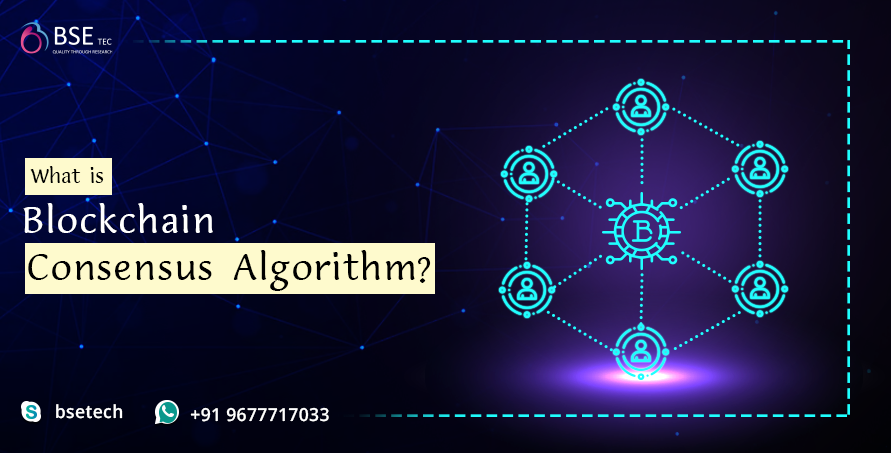What is Blockchain Consensus Algorithm?

The main benefit of blockchain technology, as we are all aware, is that it is decentralized. Usually, in a centralized space, authority is in charge of setting the regulations. But how do they come to a consensus in a decentralized setting? This is where the Blockchain consensus algorithm comes into play!
What is Consensus Algorithm?
A consensus algorithm is a process that enables every peer in a blockchain network to establish a shared understanding of the blockchain’s current state.
Types Of Consensus Algorithms:
Here is a list of different types of consensus algorithms, that are being used by major blockchain platforms.
- Proof of Work (PoW): The oldest consensus method is Proof of Work, which was incorporated into the bitcoin blockchain for validation purposes when it first launched in 2009. With the use of mining equipment, miners must solve a complex cryptographic puzzle to validate a transaction. The miner who solves the complex puzzle’s solution shares it to the other miners, who subsequently verify it and reach a consensus on whether or not the cryptographic answer is correct. The new block is added when they have validated the cryptographic solution, and the first miner to solve the puzzle receives a major reward along with the other miners who participated in the consensus. But the PoW consensus algorithm’s main drawback is that it requires extremely powerful mining and computational equipment to solve the hash functions! When the mining device’s computational power is high, it can solve the puzzle fast, but this has a lot of environmental impacts! Blockchain Platforms that use PoW: Bitcoin is the most well-known blockchain that employs PoW. However, proof-of-work is also used by other blockchains, including those for Litecoin, Bitcoin Cash, Dogecoin, and Monero.
- Proof of Stake (PoS): Unlike PoW, Proof of Stake consensus algorithm require less computational equipments it does not require solving complex cryptographic problems. Instead the validators lock up or stake the native coins for the consensus process. When the validators validate blocks they get rewards or their stake increases based on the blocks added to the blockchain. The probability of getting selected as a validator depends on the amount of crypto they have staked. The block creator is chosen with the user stake algorithm. However the validator doesn’t get block rewards, they get network fees as reward. Blockchain Platforms that use PoS: Examples of current industry-leading PoS blockchains include Polkadot, Avalanche, and Cardano. Recently, Ethereum has also shifted from PoW to PoS consensus algorithm!
- Proof of Burn (PoB): As the name suggests, Proof of Burn choose validators by the amount of cryptocurrencies they burn. Burning cryptocurrencies show your commitment towards the network, so the validators are chosen from the amount of crypto’s you have burned. Burning refers to the process of sending the coins to a “eater address” where the coin becomes useless. This address can be publicly verifiable, however it is inaccessible. Though, PoB is more sustainable and requires less energy consumption and equipments, this protocol is still new and it hasnt been tested for scalability and other issues. Blockchain Platforms that use PoB: For example, Slimcoin, a virtual currency network that uses POB.
- Proof of Authority (PoA): Identity staking is the voluntary disclosure of one’s identity in exchange for the privilege to validate blocks. This implies that the advantages you gain from it and any malicious deeds you might commit are both made public. Putting one’s identity on the line can be a tremendous equaliser. The security of a network motivates those whose identities (and, consequently, reputations) are at risk to protect the network. PoA is ideally suited for logistical applications like supply chains or trade networks because the true identities of these moderator nodes are well-known and trusted. Blockchain Platforms that use PoA: The notable platforms using PoA are VeChain, Bitgert, Palm Network and Xodex.
- Proof of Capacity (PoC): Proof of Capacity is the new consensus algorithm that is gaining momentum. Proof of capacity is also known by a variety of names like proof of space, proof of storage and other similar names. But the basic concept in the proof of capacity consensus algorithm is that the miner has allocated available memory or disk space to the network to show a financial interest in the network and also it serves as a proof that we have enough space to store the information that we have agreed upon. In order to go through the proof of capacity, the hard disk has to go through a process called plotting. Blockchain Platforms that use PoC: The most notable blockchain platform that incorporates PoC is Signum (Formerly BurstCoin).
Though all these algorithm has the same goal of coming to consensus in a decentralized platform, each has a different strategy with each having its own pros and cons. So, if you are looking for a perfect consensus algorithm for your custom private or permissioned blockchain platform, get in touch with a blockchain development company for consultations. Contact BSEtec for more details.




